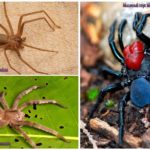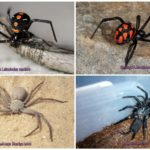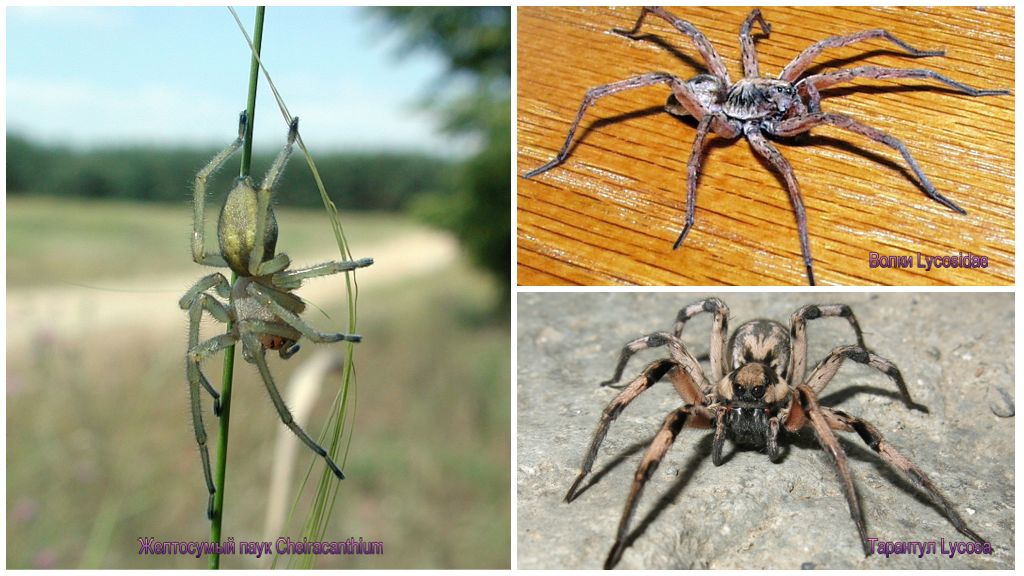Description and photos of the most dangerous spiders in the world
Content
- 1 Photos and names of dangerous creatures
- 1.1 Wolves Lycosidae
- 1.2 Tarantula lycosa
- 1.3 Cheiracanthium Yellow Mouth Spider
- 1.4 Missulena spider
- 1.5 Brazilian spider soldier Phoneutria
- 1.6 Brown recluse spider Loxosceles reclusa
- 1.7 Black widow Latrodectus mactans
- 1.8 Karakurt, steppe widow Latrodectus tredecimguttatus
- 1.9 Six-eyed sand spider lat. Sicarius hahni
- 1.10 Sydney leukopautinous, funnel spider Atrax robustus
- Poisonous spiders
- Poisonous spiders
- Poisonous spiders
Poisonous spiders are ubiquitous, but the most dangerous of them live in tropical countries. There are about 40 thousand arachnid species in the world. All of them are predators, with the exception of the steed, Kipling's buggies, which feed on acacia leaves, live in Central America.Spiders hit the victim with poison, inject saliva, which dilutes the insides, sucks the contents. The poison is so strong that it kills an animal, a person.
Photos and names of dangerous creatures
Deadly dangerous for humans spiders - exotic, living in tropical countries. Most often, locals, tourists, and people who keep the arachnid as a pet suffer from bites. How the deadly creatures where they live look can be found further in our article.
The top 10 most dangerous arachnids include spiders of various sizes and color.
Wolves Lycosidae
There are more than 2 thousand species. They live everywhere, mainly in forests with a humid climate. The predator waits for the victim in the mink, quickly rushes to attack. He rarely attacks humans. After the bite appears redness, swelling, pain. Wolves are not poisonous spiders for humans. Actively regulate the number of insects in the forest, bringing this great benefit.
Tarantula lycosa
Large arachnid. Body size reaches 3.5 cm. Lives up to 30 years. It belongs to the family of wolf spiders. They live in arid areas - steppes, deserts. Clever nets do not weave.Cobwebs cover the entrance to the mink, cocoons.
On a note!
Tarantulas that live on the territory of Russia do not pose a danger to human life, but the bite causes pain, discomfort, and weakness.
Cheiracanthium Yellow Mouth Spider
It is the most poisonous arachnid in Europe. People are rarely attacked. They live in the wild, hiding in rolled leaves. Bite people, protecting their own lives. At the site of the lesion appears swelling, suppuration. A person feels a pain in the abdomen, nausea, weakness, dizziness, headache. The condition is normalized within a week. Bites of tropical relatives of this species are much more dangerous.
Missulena spider
There are 11 known species, 10 of which live in Australia, 1 - in Chile. The name was obtained because of the erroneous opinion that they dig holes in the ground like mice. All females are black, males have spots, patterns on the body. They hunt insects, small spiders. Themselves often become victims of scorpions, wasps, centipedes. Theoretically, the poison is dangerous for humans, can cause death. However, bites occur rarely because spiders tend to stay away from human habitation.
Brazilian spider soldier Phoneutria
It lives in South America. A deadly animal leads a nomadic lifestyle, does not spin a web like most of its congeners. Often creeps into human housing, hiding in shoes, clothes, in the corners of the room. Body size about 10 cm.
On a note!
The poison of a spider can kill an infant, a weakened adult if it is not timely provided for medical care. The bites of several spider soldiers kill for half an hour a healthy person.
Brown recluse spider Loxosceles reclusa
It is found in the east of the USA. Lives up to 4 years. Females are larger than males. Leg swing up to 20 mm. During the day it hides under stones, snags, in other places where there is no bright light. At night, males hunt, females keep close to the cobweb. A person’s housing penetrates through cracks, open windows, doors, hides in corners, under furniture, clothes, bed, shoes.
Bites a person only in case of danger for his own life. Often people suffer through negligence. The bite remains imperceptible or resembles a needle prick. After some time, swelling, redness, nausea, vomiting, and other symptoms of intoxication appear.
On a note!
The complexity of the symptoms depends on the amount of poison. In some cases, tissue necrosis develops. The sore spot heals for about 6 months; a scar remains at the site of the bite.
Black widow Latrodectus mactans
A variety of poisonous spiders, known worldwide. Homeland is North America. The name of the arachnid was due to one feature - females devour males after mating. Black widows come in different sizes - from 8 to 10 mm. Females are always larger, they have a characteristic hourglass pattern on the body.
Extremely aggressive spider in the mating season. The poison spreads like lightning throughout the body, causing muscle spasms, cramps, choking. Symptoms develop within 1 hour after the attack. Often accompanied by vomiting, abdominal pain, fever, weakness.
Important!
With timely assistance, the victim recovers, otherwise everything ends in death. Particularly dangerous widow bites for children, the weak, the elderly. It is the most dangerous spider in the world, because it surpasses the rest in frequency of bites.
Karakurt, steppe widow Latrodectus tredecimguttatus
Variety of black widows.It is found almost all over the world, including in the south of Russia and Ukraine. It multiplies extremely fast, lives in burrows in the ground, weaves a web. Body size reaches 10 mm, on the upper part 13 bright spots.
From a person trying to stay away, attacks in case of danger to their own lives. The poison of karakurt is 5 times more toxic than a rattlesnake. Symptoms of poisoning develop within 15 minutes, depending on the amount of poison, immunity. Victims feel severe pain in the muscles, abdomen, vomiting, nausea, dizziness. Blood pressure rises, stenocardia appears. A person often loses consciousness. There is an antidote, but failure to provide qualified assistance may be fatal.
Six-eyed sand spider lat. Sicarius hahni
It is found in Africa, South America. Hiding in the sand, attacking the victim with lightning speed. From people trying to stay away, but if the case presents itself, be sure to bite. The poison is extremely toxic, leading to rupture of blood vessels, internal hemorrhage.
On a note!
Known cases of death. Symptoms develop a few minutes after the predator attacks, there is no antidote.Deadly spiders of this species are among the five most dangerous arthropods on the planet.
Sydney leukopautinous, funnel spider Atrax robustus
The representative of the Australian continent. Spider's poison kills a child in 15 minutes, an adult - in half an hour. Attacks unnoticed, violently. Powerful long canines calmly bite through not only the skin, but also the nail plates. An aggressive creature initially takes a fighting stance - rises on its feet, then rushes at lightning speed to attack. Bites several times in a row.
Deadly poison affects the nervous system. Within a few seconds after the bite, muscle twitching, cramps, increased salivation, tearing, shortness of breath begins. Unlike their relatives, the male is more poisonous, which is slightly inferior to the female in size, reaching 7 cm.
Web weaves in the form of a funnel. It lives in minks under the ground, hollows of trees. Clever nets do not weave. Females spend most of their lives in the burrow, males “travel” around the district in search of a couple, food. In the process of wandering often find themselves in the house of man. Photos of the most poisonous spider in the world are presented below.
Spiders bite inject poison, which causes an allergic reaction of varying degrees of intensity. Even after the attack of the krestovik spider living in our area, the temperature may rise, start a headache, nausea, weakness.











